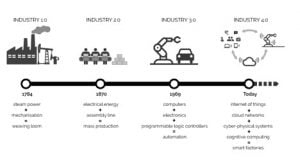Technology is integral to the future of architectural practice, but women are alarmingly absent from an emerging field. Kirsty Volz and Glenda Caldwell highlight the depressingly low percentage of women working in technology and outline some strategies for change.

Justine Clark chairs the “Challenging Our Industry – Gender Diversity in AEC and Technology” panel at the BILT conference, with Todd Battley, Glenda Caldwell and Elizabeth Harper.
At this year’s Australia New Zealand BILT (Buildings Infrastructure Lifecycle Technology) conference, held in Brisbane from 24–26 May, 84.5% of the 500 odd delegates were men. Only six of the 77 speakers at this conference were women. Recognising this imbalance, there was a panel at this conference titled, “Challenging Our Industry – Gender Diversity in AEC and Technology”, organised by the event committee, championed by Ceilidh Higgins and chaired by Parlour’s Justine Clark. The panel members for this session included Dr Glenda Caldwell from QUT, Todd Battley from AECOM, and Elizabeth Harper from GHD. It was a fantastic conversation, showcasing some of the excellent strategies Australian companies are implementing to create more inclusive workplaces. We felt that it presented a good opportunity to further the appeal for more women to work in architectural technology positions.
With the very real potential for advanced manufacturing and digital fabrication technology to seriously disrupt our industry, we desperately need more diverse perspectives on technology in architectural practice. A count of the first 100 search results for the job title ‘BIM Manager’ returns just four women. How can we address this imbalance, and why is it important to do so? Industry 4.0 (see diagram), also known as the fourth industrial revolution, is the current industrial trend, where cyber-physical systems are impacting manufacturing technologies. As architectural practice advances towards Industry 4.0, BIM Managers have become increasingly central to business operations and management. In this article, we share our concerns at the low level of engagement of women in technology within architecture and outline some reasons for why we need more women BIM Managers and technologists.

Diagram by Alan Burden.
Will robots and artificial intelligence replace architects? Probably not. According to research conducted by ABC news, automation will take over about 17% of architects’ work. And most of that work is the repetitive, tedious stuff that you’d rather not do in any case. Rather than asking if a robot will take our job, we need to be asking, ‘How will automation change the way I work?’
The biggest impact that automation will have on the construction industry is through mass customisation, which is where materials and products can be individually customised at a high volume and at a relatively low cost. Doing away with the standard sizes of mass-produced elements will change the way we design and document buildings, specify, and schedule. It also has the potential to completely disrupt the way architects do business. Indeed, we might see the rebirth of the architect as master-builder, completing work from creative conception to finished fabrication. Digital fabrication could potentially remove the need for specialised trades and building techniques, and instead an architect’s digital model could be used directly for construction processes via advanced manufacturing technologies.
The current bridge between architectural design and digital fabrication is BIM (Building Information Modelling). As we steadily march towards the implementation of advanced manufacturing in construction, architectural practices have increasingly invested in BIM technology and staff training, supporting a number of their staff into newly created roles as BIM Managers. The role of BIM Manager is something that was unheard of in architectural practice 15 years ago, but is now commonplace, with some practices employing a number of specialised BIM managers and even saving a seat for them at the executive level.
We find the potential in all of this very exciting. However, we also find the lack of women working in technology in architecture alarming. Our concerns were shared in Ceilidh Higgins article on Parlour, Will Technology Create the Next Generation Gender Divide. If we use the job title of BIM Manager as a category to analyse women’s participation in architectural technology, we very quickly arrive at some disturbing statistics.
Reliance on BIM and digital technologies will continue to grow. We need more women to be involved as architectural practice evolves with Industry 4.0. We need a diverse range of thinkers and problem solvers to work with these technologies, not a dominant representation from one gender. There are groups such as Women in BIM, which is an online, international community established in 2013 that aims to promote more women into BIM Management roles. But more needs to be done.

Andrew Mehr from BVN Architecture posted this photo on Twitter from the conference, tweeting that he was proud to say that seven of the 12 conference delegates from BVN were women.
What are some strategies? Encourage women to undertake training in software and technology, aim for gender diversity in BIM Management roles, support or encourage women who want to move into these roles. How can the impact of these women groups be scaled up to make radical change? How do we identify the barriers to adoption and what are the strategies required to introduce more women into the front lines of technological revolution and the unfolding of Industry 4.0?
Software developments, such as the parametric grasshopper plug-in to Rhino (a 3D CAD tool), are intended to make coding easier for non-computer scientists such as architectural designers. The plug-in is popular with students and designers and not surprisingly was created by a man. Revit was also created by men. The difficulty we are facing is the culmination of male-dominated disciplines, such as engineering, technology and IT, colliding with the existing inequities within the profession of architecture. We question if such software and plug-ins were designed by women for women if this would help to increase the ability and interest of women in computational design and digital manufacturing. What are the un-intended and unconscious biases portrayed through the software that dominates the industry? As we develop software for robotic arms in design-led manufacturing in the Design Robotics project, we aim to identify and address some of these issues.
Dr Glenda Caldwell and Kirsty Volz are two members of the Design Robotics Team, an industry-based research project with UAP, Queensland University of Technology and RMIT University, which is funded through the Innovative Manufacturing CRC. The team is looking at the use of advanced manufacturing in the fabrication of public art and architecture. The work will involve women in the development of software and user interfaces for the control of robotic arms and creation of robotic vision capabilities in architectural fabrication. It is hoped that through the work more women can be encouraged to engage with this technology.




















